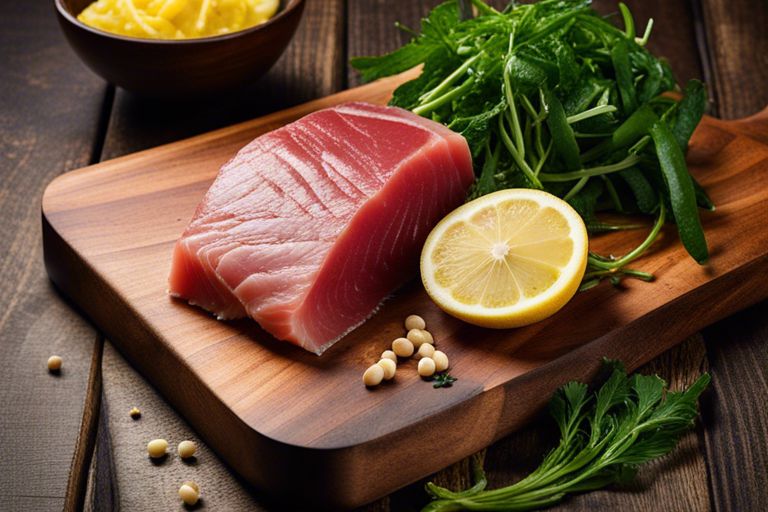Plant-based diets are gaining popularity for their health benefits, environmental sustainability, and ethical considerations, but finding satisfying alternatives to beloved foods like tuna can be challenging. In this step-by-step guide, we will show you how to create a delicious plant-based tuna substitute using soy protein and seaweed extract. Not only is this recipe packed with protein and omega-3 fatty acids, but it also mimics the taste and texture of traditional tuna without harming our oceans’ delicate ecosystems. Follow along to discover a simple and flavorful way to incorporate more plant-based options into your diet while still enjoying your favorite dishes.

Key Takeaways:
- Healthy Alternative: Plant-based tuna made from soy protein and seaweed extract offers a healthy and sustainable alternative to traditional tuna.
- Rich in Protein: Soy protein provides a substantial amount of protein in plant-based tuna, making it a nutritious option for those looking to increase their protein intake.
- Environmental Benefits: Choosing plant-based tuna helps reduce the impact of overfishing on marine ecosystems while still enjoying a flavorful and satisfying dish.
Understanding the Basics
Key Ingredients Overview
Assuming you are new to plant-based cooking, it’s necessary to understand the key ingredients required for making plant-based tuna from soy protein and seaweed extract. Soy protein is a crucial component that provides a meaty texture and protein content, while seaweed extract adds a seafood-like flavor and enhances the dish’s nutritional profile.
The Science Behind Texture and Taste
Assuming you are curious about the transformation of soy protein and seaweed extract into a convincing tuna substitute, it’s vital to investigate into the science behind texture and taste. Clearly, the interaction between the soy protein’s fibrous structure and the umami-rich compounds in seaweed extract plays a crucial role in mimicking the flakiness and savory marine taste of tuna.
Basics: For achieving a texture resembling tuna, soy protein is hydrated and restructured to imitate the muscle fibers found in fish. The addition of seaweed extract, rich in natural glutamic acid, enhances the overall umami flavor profile of the plant-based tuna.
Preparing Your Ingredients
Tips for Selecting the Right Soy Protein
If you want to make delicious plant-based tuna from soy protein, it’s important to choose the right one. Look for non-GMO and organic soy protein powder, as these will provide the best flavor and texture for your plant-based tuna. Ensure the soy protein powder is unflavored to avoid any unwanted taste in your final product. Check the ingredient list to ensure there are no additives or preservatives that may alter the taste of your plant-based tuna. After selecting the right soy protein, store it in an airtight container in a cool, dry place for maximum freshness.
How to Choose and Use Seaweed Extract
Preparing your plant-based tuna using seaweed extract can add a seafood-like flavor and a hint of the ocean to your dish. Look for high-quality seaweed extract that is organic and free from any contaminants. When using seaweed extract, start with a small amount and adjust to taste, as it can be quite potent. It is important to dissolve the seaweed extract properly in water before adding it to your plant-based tuna mixture for even distribution of flavor. Store the seaweed extract in the refrigerator after opening to maintain its freshness.
The Creation Process
All What Ingredients Actually Make Up Vegan Tuna?
Step-by-Step Guide to Making Plant-Based Tuna
| Ingredients | Method |
| Soy Protein | Combine soy protein with water and mix until it forms a paste-like consistency. |
| Seaweed Extract | Add seaweed extract slowly while stirring to ensure it is evenly distributed. |
Factors Affecting the Final Product Quality
To create a high-quality plant-based tuna, certain factors must be carefully considered.
- Ingredients: Using high-quality soy protein and seaweed extract is important for a tasty and nutritious vegan tuna.
- Proportions: The right balance of soy protein and seaweed extract is crucial in determining the texture and taste of the final product.
- Seasoning: Adding the perfect blend of spices and flavorings can elevate the taste of plant-based tuna to mimic traditional tuna.
To ensure the best results, it is important to pay attention to these factors. Any negligence in these areas may result in a subpar product.
Enhancing Your Plant-Based Tuna
Flavoring Tips for a More Authentic Taste
Many plant-based tuna recipes can be elevated by incorporating a few key flavoring tips to achieve a more authentic taste. To enhance the umami profile of your dish, consider adding soy sauce or liquid aminos. Additionally, a dash of sea salt can help mimic the oceanic essence of traditional tuna. Experiment with different combinations of seaweed extracts such as nori or dulse to further enhance the seafood-like taste. The fresh tang of lemon juice can provide a refreshing finish to your plant-based tuna creation.
The key to achieving a truly satisfying plant-based tuna dish lies in finding the perfect balance of flavors. Bear in mind, a little experimentation can go a long way in creating a dish that rivals its oceanic counterpart.
Innovative Serving Suggestions
Even traditional tuna dishes can be reinvented with a plant-based twist. To elevate your plant-based tuna experience, consider unique serving suggestions that go beyond the ordinary. To kick it up a notch, try serving your plant-based tuna in a sushi roll with avocado and pickled ginger. Transform your dish into a gourmet delight by stuffing it into a ripe tomato or incorporating it into a seaweed salad. The possibilities are endless when it comes to presenting your plant-based tuna in innovative and exciting ways.
To truly elevate your plant-based tuna experience, think outside the box and get creative with your serving ideas. Whether you’re hosting a dinner party or simply treating yourself to a delicious meal, innovative serving suggestions can take your dish to the next level.
Final Words
Conclusively, making plant-based tuna from soy protein and seaweed extract is a simple and sustainable way to enjoy a delicious and nutritious alternative to traditional tuna. By following the steps outlined in this guide, you can create a flavorful and versatile plant-based tuna that can be used in a variety of dishes. With the rising popularity of plant-based diets and the increasing concerns over our impact on the environment, this recipe provides a satisfying solution for those looking to reduce their consumption of animal products while still enjoying the taste and texture of their favorite dishes.
FAQ
Q: What are the main ingredients required to make plant-based tuna from soy protein and seaweed extract?
A: The main ingredients needed to make plant-based tuna from soy protein and seaweed extract are soy protein, seaweed extract, and flavorings such as salt, oil, and seasonings.
Q: How do you prepare plant-based tuna from soy protein and seaweed extract?
A: To prepare plant-based tuna from soy protein and seaweed extract, start by mixing the soy protein and seaweed extract with water and any desired flavorings. Then, shape the mixture into small patties or fillets and cook them in a skillet or bake them in the oven until they are golden brown and have a firm texture.
Q: What are the benefits of making plant-based tuna from soy protein and seaweed extract?
A: Making plant-based tuna from soy protein and seaweed extract is a great way to enjoy a sustainable, cruelty-free alternative to traditional tuna. Soy protein is a good source of plant-based protein, while seaweed extract provides a seafood-like flavor and texture. Additionally, this plant-based tuna is free from mercury and other contaminants commonly found in fish, making it a healthier choice for both you and the environment.

